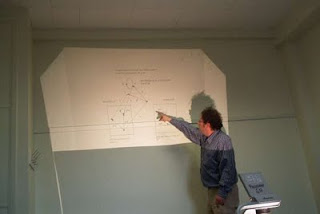Interpreting a Structure
This post is related somewhat to the previous one, but has nothing to do what what a theory is. Rather it gives an analysis of what it means to say that a structure $\mathcal{M}$ is correct under some interpretation $\mathcal{I}$.
One cannot define correctness of a structure without specifying an $\textit{interpretation}$ of the structure. Similarly, one cannot define truth of a linguistic string, say, "bajfgdhsalsbs" unless one specifies an $\textit{interpretation}$ of the language to which the string belongs. So, given a language $\mathcal{L}$, one usually defines:
Next, we can define what it means for a structure $\mathcal{M}$ to be correct, in some sense, under any given interpretation $\mathcal{I}$.
(This post is based on a talk I gave at Leeds University in 2003. Here is a photo, taken by Joseph Melia, of the talk:
)
One cannot define correctness of a structure without specifying an $\textit{interpretation}$ of the structure. Similarly, one cannot define truth of a linguistic string, say, "bajfgdhsalsbs" unless one specifies an $\textit{interpretation}$ of the language to which the string belongs. So, given a language $\mathcal{L}$, one usually defines:
1. The notion of an $\mathcal{L}$-interpretation, $\mathcal{I}$.By analogy, one wants to define:
2. The notion of a formula $\phi$ being true under $\mathcal{I}$.
1. The notion of an interpretation $\mathcal{I}$ of a structure $\mathcal{M}$.The proposed definition of "interpretation of a structure" is as follows:
2. The notion of $\mathcal{M}$ being correct under $\mathcal{I}$.
(D1) Suppose a structure $\mathcal{M}$ is given. An interpretation $\mathcal{I}$ of $\mathcal{M}$ is specified by three components:This analogous to the standard idea of interpreting a language $\mathcal{L}$. We specify a domain $D_{\mathcal{I}}$ for the quantifiers to range over, and we specify, for each primitive predicate symbol $P$, a relation $P^{\mathcal{I}}$ on the domain $D$.
(i) A domain $D_{\mathcal{I}}$.
(ii) A function $f_{\mathcal{I}} : dom(\mathcal{M}) \rightarrow D_{\mathcal{I}}$. Call this the denotation function.
(iii) For each distinguished relation $R$ in $\mathcal{M}$, a relation $R^{\mathcal{I}}$. Call this the referent of $R$ under $\mathcal{I}$.
Next, we can define what it means for a structure $\mathcal{M}$ to be correct, in some sense, under any given interpretation $\mathcal{I}$.
(D2) Let $\mathcal{M}$ be a structure and let $\mathcal{I}$ be an interpretation. Then $\mathcal{M}$ is correct under $\mathcal{I}$ just if $f_{\mathcal{I}}$ is a bijection and, for each distinguished relation $R$ of $\mathcal{M}$, $f_{\mathcal{I}}(R) = R^{\mathcal{I}}$.An example is the following. Suppose we have a very simple structure $\mathcal{M}$ such that $dom(\mathcal{M}) = \{0,1\}$, with a single distinguished relation $R = \{(0,1)\}$. This is more or less, a simple directed graph with two nodes, with one connected to the other. Let us specify an interpretation $\mathcal{I}$ as follows:
$D_{\mathcal{I}} = \{a, b\}$.This interpretation treats $0$ as denoting $a$, treats $1$ as denoting $b$, and interprets the relation $R$ as $\{(a, a)\}$. Clearly, $\mathcal{M}$ is not correct under $\mathcal{I}$.
$f_{\mathcal{I}}(0) = a$.
$f_{\mathcal{I}}(1) = b$.
$R^{\mathcal{I}} = \{(a, a)\}$.
(This post is based on a talk I gave at Leeds University in 2003. Here is a photo, taken by Joseph Melia, of the talk:
)


Interesting post! Some thoughts:
ReplyDeleteIn discussions about formal theories and their 'intended interpretations' this latter notion seems curiously indefinite between a couple of quite different things:
(i) One may think of the intended interpretation as just another kind of structure - albeit one which might contain extra-mathematical things, as in standard first-order model theory. Or,
(ii) One might think of this as some "thing" of a completely different kind. The understanding of a structure, rather than a structure itself.
This puts me in mind of Wittgenstein's discussions of interpretation and understanding. In various places, he speaks of 'interpretation' being used to mean two quite different things; on one use, an interpretation of some signs consists in more signs. In another use, an in interpretation is something like the application of some signs.
In this connection, note that one could talk about the intended interpretation of I itself: this involves, for example, that the function in I is to be regarded assigning denotations. One could even give a *further* structure which contains a function which maps the 'denotation function' to the idea of denotation, for example - or the denotation relation itself, in some non-extensional sense.
One basic moral to draw from this is that, when talking and thinking about interpretations of formal structures, we should take care to know what we are talking about (i.e. another structure - which may contain extra-mathematical objects - or something of a quite different kind).
Sorry, ignore the 'in' in 'In another use, an in interpretation'. (And don't try to read that correction out loud.)
ReplyDeleteAlso: 'One could even give a *further* structure which contains a function which maps the 'denotation function' to the idea of denotation, for example - or the denotation relation itself, in some non-extensional sense.'
ReplyDeleteOn second thoughts, there's no particular reason why the denotation relation would have to be regarded non-extensionally.
Tristan, "(i) One may think of the intended interpretation as just another kind of structure - albeit one which might contain extra-mathematical things, as in standard first-order model theory."
ReplyDeleteRight - the interpretation $I$ isn't itself a structure but it does determine one, namely $M^{I} = (D_I, \{R^{I}\})$. Then $M$ is correct under $I$ iff $f_I : M \rightarrow M^{I}$ is an isomomorphism.